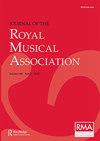“完全独立的四部曲”:马勒的悲喜剧灵感
IF 0.5
2区 艺术学
0 MUSIC
引用次数: 0
摘要
本文考察了马勒的第四交响曲及其在作曲家所谓的“完全独立的四部曲”中的作用。先前对这句话的解释包括前四部交响曲的共同歌曲引用和思想内容,但古代酒神节的戏剧呈现出更好的模式:三部严肃的悲剧和一部喜剧的羊人剧,这种表演组合也被称为“四部曲”。继马勒的前三部交响曲(他的“Leidenschaft三部曲”)之后,第四交响曲——最初名为“幽默”——被比作轻松愉快的森林之神剧,其特点是情绪的突然并列和幽默歌曲“Das himmlische Leben”的背景。对这种古老的悲喜剧并存的救赎效果的赞美在尼采的《悲剧的诞生》中发挥了重要作用,而幽默的重要性尤其影响了这位哲学家后来的作品,其中许多作品是马勒在维也纳上学时就知道的。这种新的解读不仅为马勒的评论提供了更好的解释,也说明了尼采对作曲家戏剧意识的影响。本文章由计算机程序翻译,如有差异,请以英文原文为准。
‘A Perfectly Self-Contained Tetralogy’: Mahler’s Tragicomic Inspirations
Abstract This article examines Mahler’s Fourth Symphony and its role in what the composer called his ‘perfectly self-contained tetralogy’. Previous explanations for this phrase include the first four symphonies’ shared song quotations and ideological content, but the dramas of ancient Dionysian festivals present a better model: three serious tragedies and a comic satyr play, a performance grouping also known as a ‘tetralogy’. Following Mahler’s first three symphonies (his ‘Trilogie der Leidenschaft’), the Fourth Symphony – originally entitled ‘Humoreske’ – is compared to a light-hearted satyr play, featuring abrupt juxtapositions of moods and a setting of the humorous song ‘Das himmlische Leben’. Praise for the redemptive effects of this ancient tragicomic juxtaposition plays an important role in Nietzsche’s The Birth of Tragedy, and the importance of humour especially shaped the philosopher’s later writings, many of which Mahler knew from his time as a student in Vienna. This new reading not only provides a better explanation for Mahler’s comment, but also illustrates Nietzsche’s influence on the composer’s sense of drama.
求助全文
通过发布文献求助,成功后即可免费获取论文全文。
去求助
来源期刊
CiteScore
0.50
自引率
0.00%
发文量
16
期刊介绍:
The Journal of the Royal Musical Association was established in 1986 (replacing the Association"s Proceedings) and is now one of the major international refereed journals in its field. Its editorial policy is to publish outstanding articles in fields ranging from historical and critical musicology to theory and analysis, ethnomusicology, and popular music studies. The journal works to disseminate knowledge across the discipline and communicate specialist perspectives to a broad readership, while maintaining the highest scholarly standards.

 求助内容:
求助内容: 应助结果提醒方式:
应助结果提醒方式:


